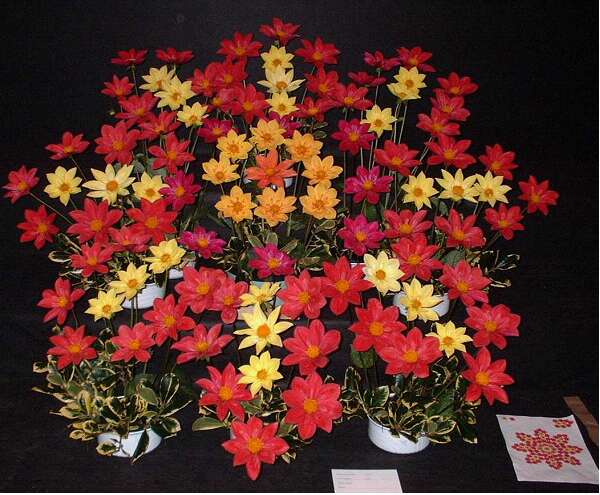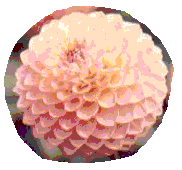 THE GROWING WORLD OF DAHLIAS
THE GROWING WORLD OF DAHLIAS
![]()
|
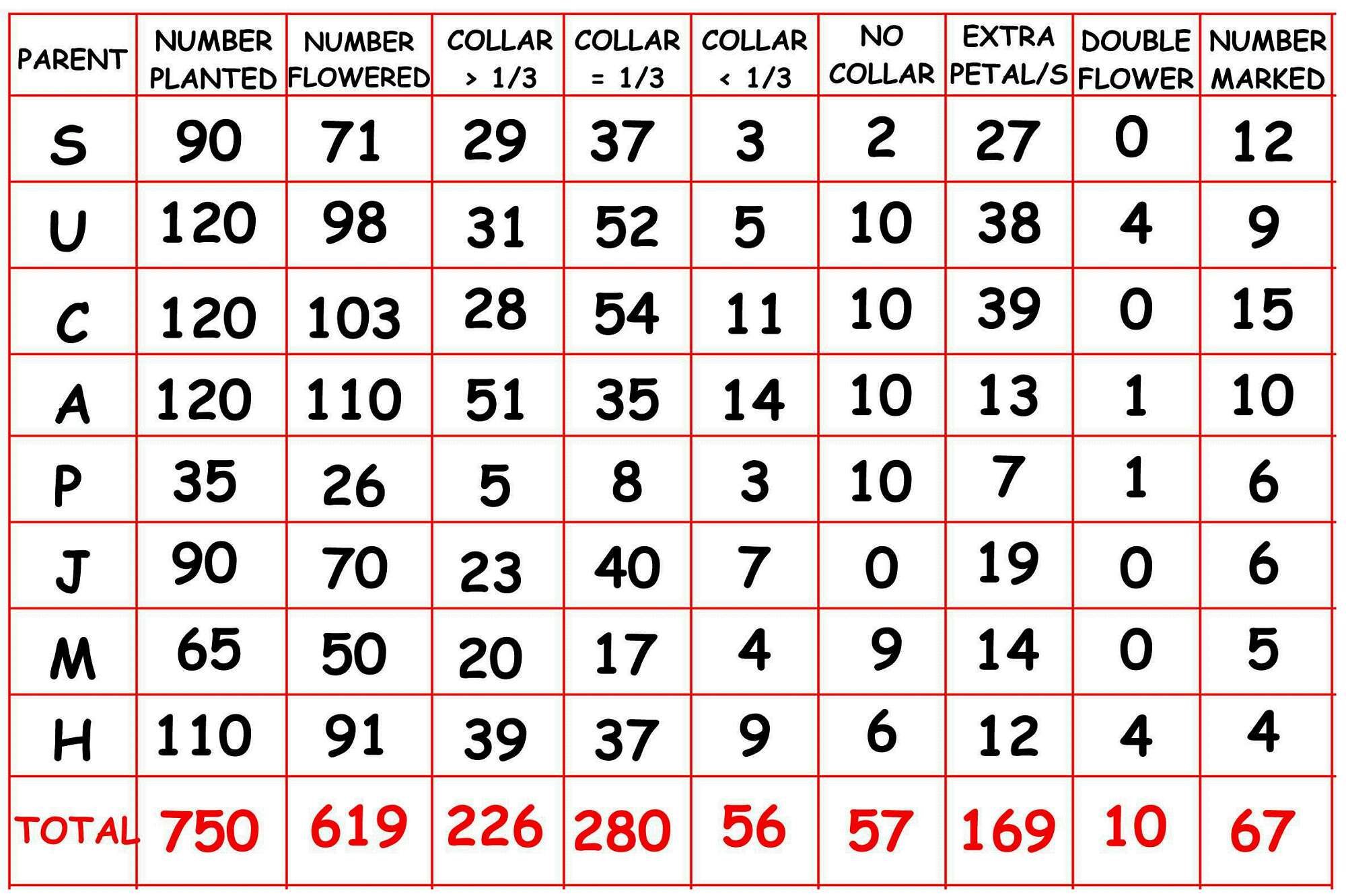
INFORMATION RESULTING
1). Percentage of seed sown (144) to reach planting out stage. (P and M were not
all planted
out because of time and space.) Losses were due to some not germinating, others
being
too spindly, damage being caused when transplanting and a few too poor to plant
out.
| S | U | C | A | P | J | M | H |
| 62.5 | 83.3 | 83.3 | 83.3 | 62.5 | 76.4 |
2). Percentage of seed sown (144) to reach first flower stage. (Again P and M
not included.)
| S | U | C | A | P | J | M | H |
| 49.3 | 68.1 | 71.5 | 76.4 | 48.6 | 62.5 |
3). Total planted out was 750. The number to reach flowering stage was 619
(82.5%).
The individual percentages were:-
| S | U | C | A | P | J | M | H |
| 78.9 | 81.7 | 85.8 | 91.7 | 74.3 | 77.8 | 76.9 | 82.7 |
4). The number of first flowers to have collar petals of > 1/3 of the main petal
length was
226 (36.5%). The individual percentages were:-
| S | U | C | A | P | J | M | H |
| 40.8 | 31.6 | 27.2 | 46.4 | 19.2 | 32.9 | 40.0 | 42.9 |
5). The number of first flowers to have collar petals of just 1/3 of the main
petal length
was 280 (45.2%). The individual percentages were:-
| S | U | C | A | P | J | M | H |
| 52.1 | 53.1 | 52.4 | 31.8 | 30.8 | 57.1 | 34.0 | 40.6 |
The requirement for collerettes is that they must have collars of at least 1/3
the length
of the main petals. So of the 619 plants to reach first flowers, 226 + 280 (506)
were
collerettes (81.7%). In the first year I hybridised collerettes I managed only
8%, but in
2003 this had increased to nearly 90%. The individual percentages are:-
| S | U | C | A | P | J | M | H |
| 93.0 | 84.7 | 79.6 | 78.2 | 50.0 | 90.0 | 74.0 | 83.5 |
6). The number of first flowers to have no collar was 57 (9.3%). This included
those
classified as single or double flowered. The individual percentages were:-
| S | U | C | A | P | J | M | H |
| 2.8 | 10.2 | 9.7 | 9.1 | 38.5 | 0 | 18.0 | 6.6 |
7). The number of first flowers with one or more extra petals was 169 (27.3%).
The NDS
judging rules state that the number of outer florets for collerettes �may vary
from
eight upwards, BUT they must not assume double formation�. So an extra petal is
not
a fault unless it starts a second layer. However, in general one or more extra
petals
crowd each other and distract from the appeal of the bloom. Also a good vase
needs
to have all blooms the same. So one or more extra petals is undesirable when
breeding
new varieties. It should be pointed out that an extra petal on a first flower
may not
indicate an inherent genetic fault and further flowers on that plant may have
only the
standard eight petals. It is quite common for new collerettes to have thirteen
petals �
this fits the Fibonacci series 1,2,3,5,8,13,21��. The individual percentages
were:-
| S | U | C | A | P | J | M | H |
| 38.0 | 38.8 | 37.9 | 11.8 | 26.9 | 27.1 | 28.0 | 13.2 |
8). Only 10 of the 619 first flowers were fully double (1.6%). Two of the seed
parents produced 4 each and another two produced one each. In the case of
JACQUIE
HURST this is not surprising as its seed parent was a waterlily. The other seed
parent to
produce four double first flowers was SUE MOUNTJOY (uncovered) while the covered
SUE MOUNTJOY plants produced none. Is this a clear indication that the sources
of
pollination were different?
Two of the double flowers were very interesting. One had standard collerette
petals on
each main petal, although they could not be seen in the smaller main petals as
they were
curled inwards. As the collar petals were the same yellow as the main petals
they did not
show well.
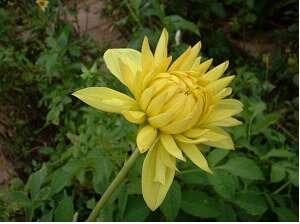 |
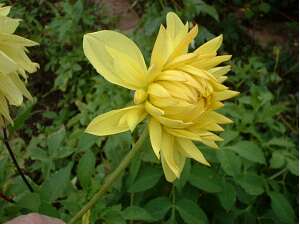 |
With hindsight I think the other double was more interesting as the collar
petals were
distinctly different in colour from the main petals and the format was of a
waterlily/collerette combination. Sadly this one was dumped. It would have made
a very
interesting entry in the NDS seedling class covering waterlilies, collerettes,
miscellaneous,
single-flowered and anemone classifications!
This seedling had Teesbrooke Audrey as the seed parent.
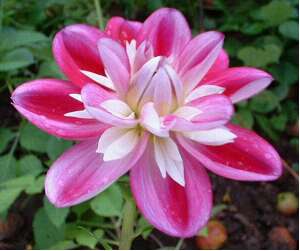
|
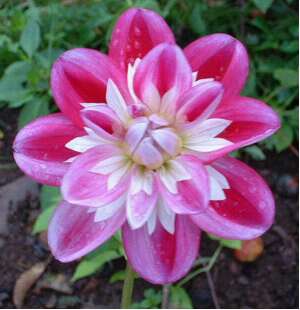 |
9). Altogether 67 seedlings were marked for consideration for trial in 2005,
(10.8%).
Several of these produced inferior second and third flowers and will therefore
be
discarded. One was unintentionally dug out! Others were subsequently ruled out
as the
stem or plant structure was deemed poor. Two double-flowered seedlings were kept
for
novelty value. So the figures given in the data box below indicate the number of
seedlings selected on the first flower only. However they show some differences
between seed parents. The individual percentages were:-
| S | U | C | A | P | J | M | H |
| 16.9 | 9.2 | 14.6 | 9.1 | 23.1 | 8.6 | 10.0 | 4.4 |
This is the first year that seedlings could be taken from DEMI SCHNEIDER. All
the
seedlings made sturdy plants. The most notable feature of the selected seedlings
is the
colour of most of the collars � reds and in two cases, orange. Another factor is
that all
the selected cultivars have medium width main petals which overlap neatly and
lie in a
flat plane. On this evidence this variety seems to give rise to a good
percentage of
potential exhibition varieties of distinctively different colours.
The uncovered SUE MOUNTJOY (U) again gave rise to some interesting combinations
of
main petal/collar petal colours as well as at least one yellow/yellow type that
could be
a winner. Another that stood out was in delicate shades of pink which in the
garden
had a translucent appearance, not captured in the photograph. The range of
colours and
petal shape are certainly different to those seen in the SUE MOUNTJOY (C)
seedlings.
The covered SUE MOUNTJOY (C) seedlings selected for further trial, included
several
vibrant red seedlings, but also several blander pink/pink combinations and a
rare orange
(collar same) and a flame orange variety. Two double colour outer floret
seedlings where
the deeper colour appears to have been �brushed on� are first time additions to
the large
range of colours emanating from this prolific seed parent. Approximately one in
seven of
the seedlings from this source has exhibition potential.
The selected seedlings from TEESBROOKE AUDREY (A) are in general of more
delicate
colours than the seed parents above, but yielded near the average amount of
seedlings
worth further testing. Most of the seedlings were tall, but leggy. However, most
of
those selected made very strong plants which yielded many blooms. While not a
detrimental characteristic, it is apparent that almost all the selected
seedlings have
collars of a very similar colour to the main petals. One of the seedlings was
selected
because it had a red disc. This is not surprising as Phil Orley who raised T. A.
achieved
this phenomenon a year or two ago and exhibited a vase at the NDS Annual Show.
The percentage yield of seedlings showing exhibition potential from PATRICIA (P)
was
the highest of the seven varieties in this study, although the number of
seedlings
planted was very low so comparison has to be considered proportionately. But
those
selected were interesting. One showed the red disc syndrome (p31). The photo of
this
shows one distorted petal � this did not occur in subsequent flowers. P7 proved
to be
quite a good waterlily, while p4 was a very pleasing cream colour. Three of the
five
collerette types selected were of similar colours to the seed parent.
The selected seedlings from EDITH JONES (J) were inevitably of similar colours
to the seed parent, because most of the seedlings followed this pattern.
However, there
was one which was a striking combination of pale yellow with a pink collar. The
others
had very full collar petals which stood out.
The selected seedlings from DEE MORRELL (M) were all strong colours with three
like
the seed parent. In each of these the big difference was the very distinctive
collar
colours. M25 has a yellow base with red �brushed on� and increasing in depth of
colour
towards the base of the petals. All five of the seedlings made small, low
growing plants
with quite short stemmed flowers � just like the parent. This is not desirable.
The selected seedlings from JACQUIE HURST were very different in colour to the
parent. Two are white and two are yellow � but they retain the classic
collerette form
of the parent. The red seedling h1 was the best of a poor lot � the yield from
this seed
parent was by far the lowest of the seven varieties used as seed parents.
PHOTOGRAPHS OF THE SELECTED SEEDLINGS
These are shown in the next chapter.
6 foot wide �collerette� arrangement of IJK raisings at National Show, 2004
